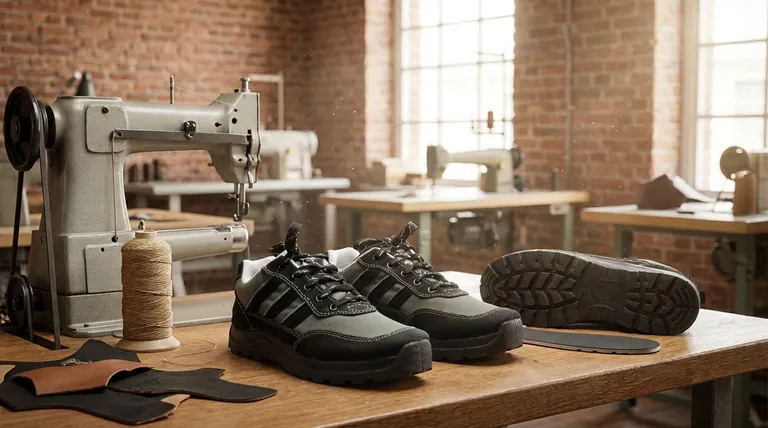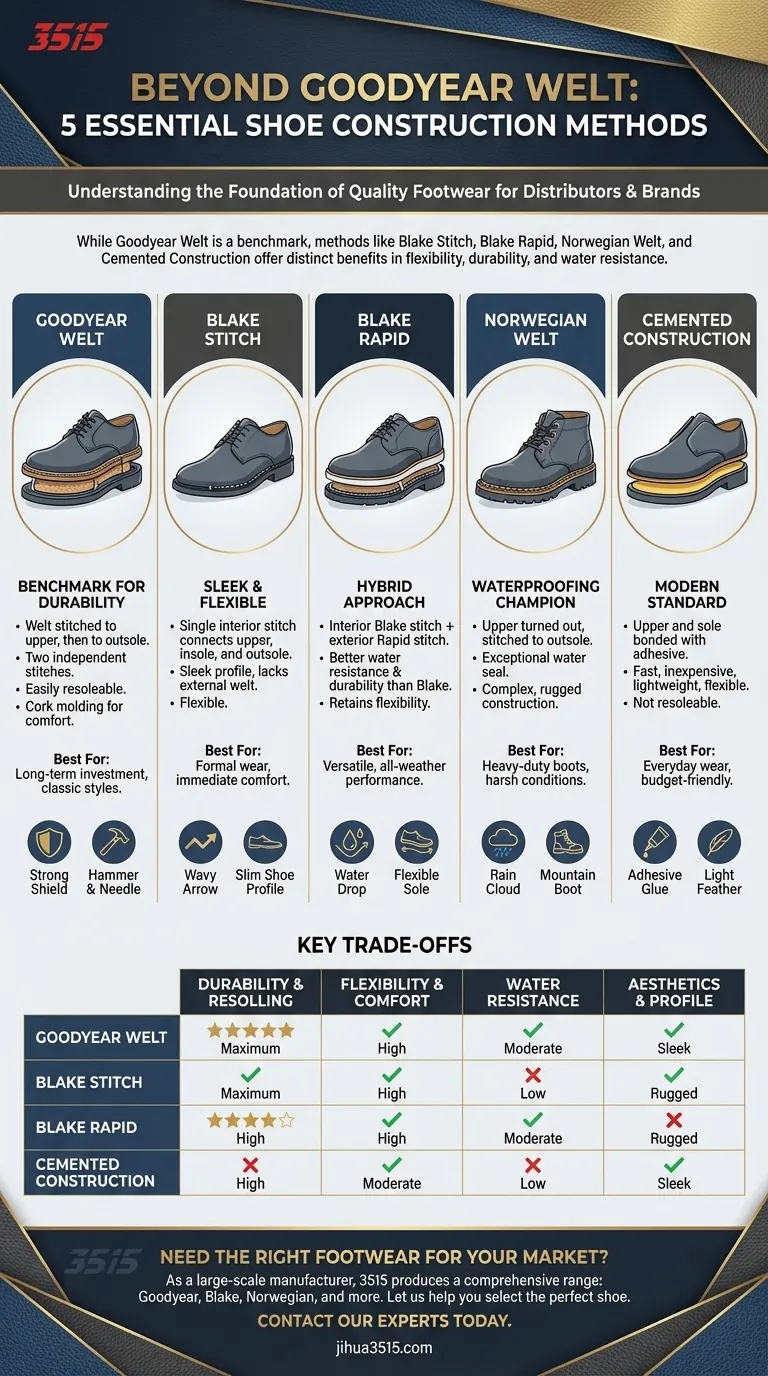In short, the most common alternatives to Goodyear welt construction are the Blake stitch, Blake Rapid, Norwegian welt, and cemented construction. Each method directly impacts a shoe's flexibility, durability, water resistance, and ease of repair, offering a distinct set of characteristics suited to different needs and price points.
The core difference between these methods lies in how the shoe's upper is attached to the sole. While a Goodyear welt uses a separate leather strip as a robust intermediary, alternatives connect the upper and sole more directly, resulting in different performance trade-offs.

Understanding the Construction Methods
To choose the right shoe, you must first understand how it's put together. The construction method is the foundation of a shoe's character—its flexibility, lifespan, and overall feel.
The Goodyear Welt: The Benchmark for Durability
A Goodyear welt is a strip of leather sewn around the bottom edge of the shoe's upper. This welt is then separately stitched to the outsole.
This creates two independent stitches, meaning the sole can be replaced multiple times without disturbing the upper. This process also creates a cavity filled with cork, which molds to your foot over time.
The Blake Stitch: The Sleek and Flexible Alternative
In a Blake stitch construction, the upper is folded under the insole and stitched directly to the outsole. This single interior stitch creates a more direct connection.
The result is a shoe that is significantly more flexible and lighter than its Goodyear-welted counterpart. The profile is also sleeker and more close-trimmed, as it lacks the external welt.
The Blake Rapid: A Hybrid Approach
Blake Rapid construction combines elements of both methods. It features the same interior Blake stitch connecting the upper and insole, but it also adds a midsole that is then stitched to the final outsole.
This "rapid" stitch is on the exterior of the shoe, making it look similar to a Goodyear welt at first glance. It offers better water resistance and durability than a standard Blake stitch while retaining good flexibility.
Norwegian (Norvegese) Welt: The Waterproofing Champion
The Norwegian welt is a highly robust and water-resistant construction. The upper leather is turned outward and stitched directly to the outsole, with visible stitching running around the shoe's exterior.
This method creates an exceptionally secure seal against the elements, making it a popular choice for rugged boots and all-weather footwear. It is a complex and labor-intensive process.
Cemented Construction: The Modern Standard for Casual Shoes
Cemented construction is the most common method in modern footwear. The upper and sole are simply bonded together using a strong adhesive.
This method is fast, inexpensive, and allows for the use of non-traditional sole materials like rubber and synthetics. It produces a very lightweight and flexible shoe right out of the box.
Key Trade-offs: What You Gain and What You Lose
No single construction method is universally "better." The right choice depends entirely on your priorities, whether they be longevity, comfort, or style.
Durability and Resoling
A Goodyear welt is the gold standard for resoling. A cobbler can easily remove the old sole and stitch on a new one without compromising the shoe's structure.
Blake Rapid shoes are also easily resoleable. In contrast, standard Blake-stitched shoes require a specific Blake machine for resoling, which not all cobblers have. Cemented shoes are generally considered disposable and are not designed to be resoled.
Flexibility and Comfort
Blake-stitched and cemented shoes offer the most out-of-the-box flexibility and a shorter break-in period. Their simpler construction makes the sole less rigid.
Goodyear welted shoes are notoriously stiff at first due to the multiple layers (welt, cork, shank). However, they become exceptionally comfortable as the cork footbed molds to your foot.
Water Resistance
The external stitching and welt of the Norwegian and Goodyear methods offer superior protection against water. The welt acts as a barrier, preventing water from seeping in where the upper meets the sole.
A Blake stitch is more vulnerable to water, as the single stitch can wick moisture directly into the shoe's interior.
Aesthetics and Profile
The lack of an external welt allows Blake-stitched shoes to have a very sleek, close-cut sole. This creates a more elegant and formal silhouette.
The Goodyear welt adds slight bulk around the perimeter of the shoe, resulting in a more substantial and arguably more casual appearance.
Making the Right Choice for Your Goal
- If your primary focus is maximum durability and longevity: A Goodyear welt is the undisputed choice, allowing for years of use and multiple resoles.
- If your primary focus is immediate comfort and a sleek, formal profile: A Blake stitch offers superior flexibility and a refined look straight from the box.
- If your primary focus is waterproofing and ruggedness: A Norwegian welt provides the best possible protection against the elements for heavy-duty footwear.
- If your primary focus is affordability and lightweight casual wear: Cemented construction delivers a comfortable, accessible shoe for everyday use.
Ultimately, understanding these construction methods empowers you to look beyond the brand and evaluate a shoe based on its fundamental quality and purpose.
Summary Table:
| Construction Method | Key Characteristic | Best For |
|---|---|---|
| Goodyear Welt | Maximum durability, easy resoling | Long-term investment, classic styles |
| Blake Stitch | Sleek profile, immediate flexibility | Formal wear, comfort-focused |
| Blake Rapid | Hybrid durability & flexibility | Versatile, all-weather performance |
| Norwegian Welt | Superior waterproofing, ruggedness | Heavy-duty boots, harsh conditions |
| Cemented | Lightweight, affordable, casual | Everyday wear, budget-friendly |
Need the right footwear construction for your market?
As a large-scale manufacturer, 3515 produces a comprehensive range of footwear for distributors, brand owners, and bulk clients. Our production capabilities encompass all types of shoes and boots, from durable Goodyear welted classics to sleek Blake stitch formalwear and rugged Norwegian welt boots.
Let us help you select or manufacture the perfect shoe for your customers' needs. Contact our experts today to discuss your project and get a quote.
Visual Guide

Related Products
- Durable Rubber-Soled Utility Shoes for Wholesale & Custom Brand Manufacturing
- Wholesale Breathable Training Shoes Custom Athletic Footwear Manufacturer
- Wholesale Durable & Breathable Training Shoes for Custom Brands
- Lightweight Breathable Training Shoes for Wholesale & Custom OEM Manufacturing
- Wholesale Breathable & Cushioned Training Shoes Custom Factory Production
People Also Ask
- What are rubber soled shoes? The Ultimate Guide to Durable, All-Weather Footwear
- What historical breakthrough in 1844 contributed to modern shoe sole manufacturing? The Vulcanization Revolution
- What are the main applications of vulcanized rubber? Unlock Durability for Tires, Footwear & More
- What makes natural rubber provide excellent traction and grip? Unlocking Superior Performance with Molecular Science
- What are the benefits of rubber work shoes? Unbeatable Protection for Wet & Demanding Jobs



















